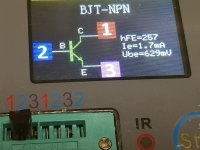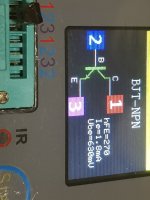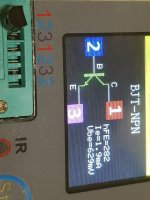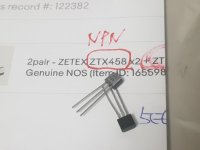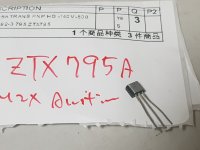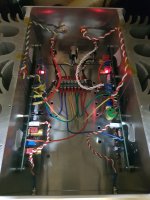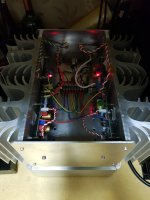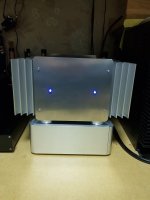@Dennis Hui
I've purchased 2SJ74 from here https://www.ebay.com/itm/252915277698
I've checked those places and soldered parts one by one with my BOM (link) sheets and filled in cell with yellow color.
I've purchased 2SJ74 from here https://www.ebay.com/itm/252915277698
I've checked those places and soldered parts one by one with my BOM (link) sheets and filled in cell with yellow color.
@namghiwook : As Anand also pointed out earlier, your bipolar transistors don't look like the original Zetex parts. Can you measure run your Mega328 on the ones you have? What do their hFE and Vf or Uf look like?
Please let us know what happens after reflowing the solder and cleaning the PCBs.
Thanks,
Dennis
Please let us know what happens after reflowing the solder and cleaning the PCBs.
Thanks,
Dennis
I desoldered Q2,3,4.@namghiwook : As Anand also pointed out earlier, your bipolar transistors don't look like the original Zetex parts. Can you measure run your Mega328 on the ones you have? What do their hFE and Vf or Uf look like?
Please let us know what happens after reflowing the solder and cleaning the PCBs.
Thanks,
Dennis
The desoldered Q3,4 (ZTX450) is NPN.
The desoldered Q2 (ZTX550) is NPN. woops.
These ZTXs seem to be fake.
I have ZTX795(PNP) and ZTX458(NPN).
Can I use these?
Attachments
Sadly what you got from ebay are fake.
Yup, you can use ZTX795 and ZTX458. Note the shape of these parts are different from what you got from ebay.
Try these and see.
Yup, you can use ZTX795 and ZTX458. Note the shape of these parts are different from what you got from ebay.
Try these and see.
Thank you!
@Dennis Hui @Ben Mah @KevinHeem @poseidonsvoice
Finally, I built Aleph J after changing Q2,3,4 BJT transistors.
But I worry about turn off big cracking sound even with my 83db speaker.
@Dennis Hui @Ben Mah @KevinHeem @poseidonsvoice
Finally, I built Aleph J after changing Q2,3,4 BJT transistors.
But I worry about turn off big cracking sound even with my 83db speaker.
Attachments
As ZM wrote, crackling sound is not normal. My own AJ clone has a mild turn off thump.
Please post photos and schematics of your external power supply as well. You seem to have two sets of ground wires?
Please post photos and schematics of your external power supply as well. You seem to have two sets of ground wires?
fishy, cracking is not normal…
It is if you use an SLB PSU.
Edit:
SLB = Smooth Like Butter.
An Aleph J should exhibit no more than a soft thump upon turn off.
The SLB boards require (yes, require) at least 10,000 uF, and up to 36,000 uF of bulk capacitance on their output to function correctly. This can be in various forms, including several 10,000 uF caps remaining from previous projects.
The SLB boards require (yes, require) at least 10,000 uF, and up to 36,000 uF of bulk capacitance on their output to function correctly. This can be in various forms, including several 10,000 uF caps remaining from previous projects.
Wasn't one of the design goals of the SLB PS reduced amount of capacitors to reduce cost and overall physical size of the PS?
https://www.diyaudio.com/community/...ct-crc-cap-mx-class-a-power-supply-gb.336479/
https://www.diyaudio.com/community/...ct-crc-cap-mx-class-a-power-supply-gb.336479/
A capacitance multiplier is good at reducing ripple in the power supply. It is not a substitute for energy storage. So the bulk capacitance and physical size remains the same or larger (due to the extra pass transistors).
My point is that XRK971 intended it to not require additional capacitance. From the pictures, it has 30mF of capacitance per rail. The schematic shows it as a CRC of 15mF-0.2R-15mF in front of the capacitance multiplier. For a Class A amplifier is that not a reasonable amount of capacitance?
Yes, regardless of intent, a CapMx supply will not function correctly without capacitance on its output. The input filter is just enough to reduce initial ripple to a point where the pass transistors (complementary feedback pair in this case) can bring the output ripple to an acceptable level. The final bulk capacitor(s) form a low frequency pole in conjunction with the speaker impedance. We want this to be the lowest pole in the amp/speaker system. Both transistors in the CFP need to have low Vcesat figures. That prevents the pass element from snapping off prematurely.
I have used SLB boards in my F6 and DIY Sony VFET amps. They work quite well when done properly. I tried building both amps with and without the extra bulk capacitance. Both examples exhibited a clear improvement in performance with the extra caps. Fortunately the bulk capacitors don't need to take up too much floor space. Kemet makes some excellent screw terminal capacitors with 40V rating in 24,000 uF and 36,000 uF models.
I have used SLB boards in my F6 and DIY Sony VFET amps. They work quite well when done properly. I tried building both amps with and without the extra bulk capacitance. Both examples exhibited a clear improvement in performance with the extra caps. Fortunately the bulk capacitors don't need to take up too much floor space. Kemet makes some excellent screw terminal capacitors with 40V rating in 24,000 uF and 36,000 uF models.
My point is
I'm not familiar with developing process of these circuits, but when I spotted some guys using cap multiplier without final cap bank, I did comment that final cap bank is absolutely necessary - no replacement for displacement and cap multiplier isn't anything else than Beancounter's choke......... so ..........
and boyz who tried what I wrote informed of much better behavior after installing some proper capacitance where it needs to be
Only MZM can defy the laws of physics. For us mere mortals, mass, size and a modular approach matter. Take the H-bomb, for example.
Hmm, looks like I'll be adding a cap bank to my amplifier soon...
I had the same turn off noises @namghiwook is experiencing and was fearful for my speakers as well. I ended up adding speaker protection to the amp.
I had the same turn off noises @namghiwook is experiencing and was fearful for my speakers as well. I ended up adding speaker protection to the amp.
- Home
- Amplifiers
- Pass Labs
- Aleph J illustrated build guide
